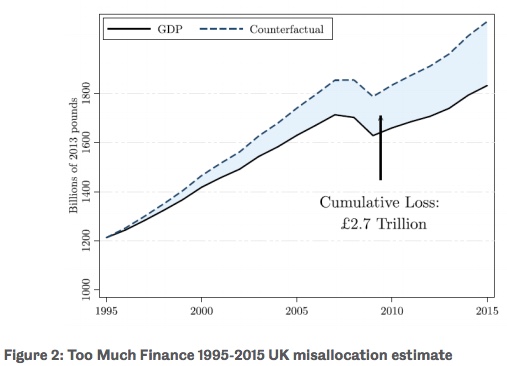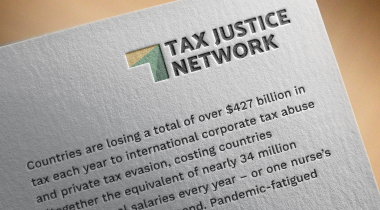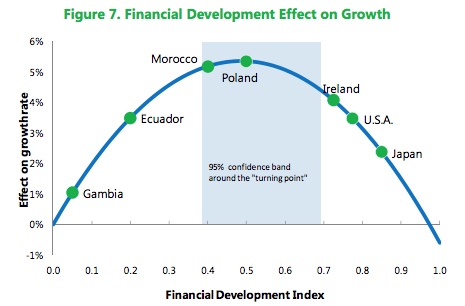
Nick Shaxson ■ The Finance Curse and the £4.5 trillion hit to the UK economy

The Finance Curse, a concept first developed by John Christensen and Nicholas Shaxson for TJN, is now the subject of a Long Read article in The Guardian.
The article mentions a new study by Andrew Baker of the University of Sheffield, Gerald Epstein of the University of Massachusetts Amherst, and Juan Montecino of Columbia University, estimating that the UK has suffered a cumulative £4.5 trillion hit to its GDP from 1995-2015, due to its financial sector being too large and having turned away from its proper traditional functions towards more harmful and predatory ones. That is equivalent to 250 percent of GDP – or £170,000 per UK household.
That report is here (also here.) The image above shows the essence of what the report is looking at: if Britain had had an optimal, smaller financial sector focused on its traditional beneficial roles, it would have had a higher growth trajectory represented by the line A, but in the real world it had a lower growth trajectory due to oversized finance, on line C. (The £4.5 trillion, for wonks, is the area of the graph between lines A and C.)
How do they calculate this? Well, it’s (conservatively) the sum of two components. First is the long-running cost of the global financial crisis and its aftermath, which looks like this:
(This is a pretty standard calculation, and this £1.8 trillion is quite compatible with estimates by Andrew Haldane of the Bank of England, and others.)
Second, there’s a category called “misallocation” – which is, roughly, the £2.7 trillion damage to economic growth due to finance distorting the economy, and extracting wealth from it. That category looks like this:
In other words, economic growth has been lower, year after year, than it would have been if finance had been at its optimal size and serving its proper functions.
If you’re looking for examples of “misallocation”, look at this recent post, or this new Guardian Long reads article, or for the Full Monty, the Finance Curse book, now being launched.
Adding these two figures – £1.8 trillion in crisis costs, and £2.7 trillion in misallocation costs, and you get £4.5 trillion (obviously taking care to avoid double counting: as the study explains, the data being used already “controls for business cycles associated with financial crises.”)
But wait! There’s a third category, known as “excess rent,” which is, roughly, too much profit and too much remuneration flowing to finance, over and above what they should earn for providing their services. (Banking billions, billionaires and bonuses, you might call it.)
That’s a further £700 billion. The academics don’t add this to the £4.5 trillion total to get £5.2 trillion, because a fair chunk of those excess rents are from overseas. But there’s a good case to be made that plenty of it should be added. (People may try to push back against this idea, saying that excess rents are simply a transfer from one part of the economy to another. To get a sense why this isn’t so, imagine Amazon’s boss Jeff Bezos walks into a bar. Suddenly everyone in the bar is, on average, a billionaire. But to get a sense of how well they’re all really doing, you need to remove Bezos’ billions from the calculation.)
The point is, the £4.5 trillion is a conservative total. (What is more, the damage is calculated up to 2015 – but the damage has continued to mount since then.)
What is the optimal size, and how do they calculate the damage?
There’s a whole body of academic research out there now which is known as “Too Much Finance” – all of which shows the same basic relationship. This research is summarised here.
As a financial sector in a country develops, it tends to support other parts of the economy – but only up to a point. There are several papers with graphs showing the same basic inverted u-shaped relationship – here’s one, from the IMF:
The Baker / Epstein / Montecino report uses a different, and more widely used metric, than the one in this graph, and that’s the ratio of credit to the economy, to GDP. The ‘sweet spot here’, the IMF and others have found, is when this credit, on the relevant measure, hits around 90-100 percent of GDP. The UK passed that point long ago, and over 1995-2015 averaged around 160 percent.
Based on where the UK is on the curve, and the angle of slope at that point, you can then get a rough estimate of the annual hit to growth. Then you add it up over the years.
A back of the envelope estimate is that a 1.2 percent annual hit to growth will get you to 250 percent of lost GDP over 20 years. (Here’s how it works: in Year 1 your GDP is 1.2 percent smaller than it should have been. In year 2, your GDP starts 1.2 percent lower, and loses another 1.2 percent, for 2.4 percent. In year 3, you’re down 3.6 percent. Pretty soon, you’re talking real money.
The UK’s Finance Curse? Costs and Processes. Take a look.
It follows an earlier study by Epstein and Montecino, looking at the growth costs to the US of oversized finance:
we estimate that the financial system will impose an excess cost of as much as $22.7 trillion between 1990 and 2023, making finance in its current form a net drag on the American economy.
That was the first of its kind for the US, and this is the first of its kind for the UK.
This article has been adapted slightly from financecurse.net, a new website.
Related articles

The Financial Secrecy Index, a cherished tool for policy research across the globe

New Tax Justice Network podcast website launched!

Como impostos podem promover reparação: the Tax Justice Network Portuguese podcast #54

Convenção na ONU pode conter $480 bi de abusos fiscais #52: the Tax Justice Network Portuguese podcast

As armadilhas das criptomoedas #50: the Tax Justice Network Portuguese podcast

The finance curse and the ‘Panama’ Papers

Monopolies and market power: the Tax Justice Network podcast, the Taxcast

Tax Justice Network Arabic podcast #65: كيف إستحوذ الصندوق السيادي السعودي على مجموعة مستشفيات كليوباترا

Remunicipalización: el poder municipal: January 2023 Spanish language tax justice podcast, Justicia ImPositiva




